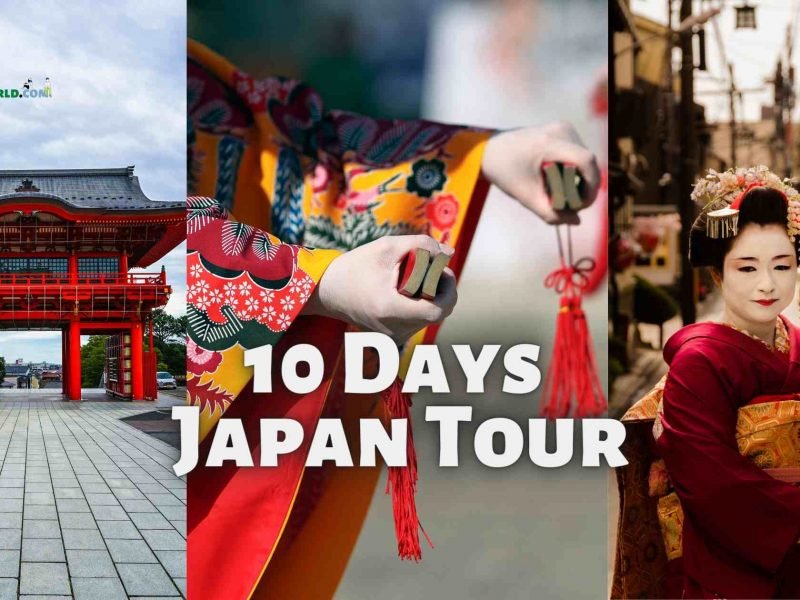About Shitennoji
About Shitennoji – It is a Buddhist temple in Osaka, Japan, and is thought to be one of the oldest temples in Japan, dating back over 1,400 years. It is also one of the country’s largest and most important temples, as well as a declared National Treasure of Japan.
Prince Shotoku, who is credited with introducing Buddhism in Japan, founded the temple in 593 AD. It is called after the Four Heavenly Kings (Shitenno), who are Buddhist protectors and guardians of the four cardinal directions.
Shitennoji has been renovated and expanded multiple times throughout its history due to natural calamities, political turmoil, and conflicts. Although the temple has been demolished and rebuilt multiple times, it has always served as an important religious and cultural center in Osaka.
The temple complex is spread across a huge plot of ground and includes various significant structures such as the Kondo (main hall), the Gokuraku-jodo Garden, the Tahoto Pagoda, and the Shitennoji Museum.
The Kondo is the temple’s main hall and the oldest wooden structure in Japan, having been rebuilt in 711 AD. It is home to a number of significant Buddhist statues and relics, including a statue of Prince Shotoku and a wooden statue of Shaka Nyorai (the Historical Buddha).
The Gokuraku-jodo Garden, located behind the Kondo, is a Japanese-style garden with a huge pond, multiple bridges, and a tea shop. The garden is intended to depict the Buddhist concept of heaven, and it is a popular area for visitors to unwind and take in the landscape.
The Tahoto Pagoda is a five-story pagoda in the temple complex’s southeast corner. It was restored in 1974 as a reproduction of the original pagoda from the 15th century.
The Shitennoji Museum, located in the temple complex’s west corner, houses a collection of Buddhist statues, paintings, and relics, as well as historical papers and images from the temple’s history.
Shitennoji is a significant religious and cultural monument in Japan, with millions of tourists each year. It is also a major emblem of Osaka’s history and legacy, as well as a monument to Buddhism’s ongoing power in Japan.
History timeline of Shitennoji
It is thought that Prince Shotoku, who is credited with introducing Buddhism in Japan, established the Shitennoji Buddhist Temple in Osaka, Japan, around the year 593 AD. Shitennoji is located in Japan. The following is a condensed version of Shitennoji’s historical timeline:
593 AD: It is thought that Prince Shotoku, a key figure in the dissemination of Buddhism throughout Japan, laid the groundwork for the establishment of Shitennoji in the year 593 AD.
8th century: In the eighth century, the temple was frequently destroyed and again reconstructed as a result of political upheaval and natural disasters.
1598: In the year 1598, the strong daimyo and military leader Toyotomi Hideyoshi issued an order that called for the temple to be rebuilt and expanded.
1615: During the Siege of Osaka, which occurred in 1615, the armies of the Tokugawa shogunate and the Toyotomi clan fought a decisive struggle for control of the city. The temple was destroyed during this conflict.
1623: Tokugawa Iemitsu, the third shogun of the Tokugawa shogunate, oversaw the reconstruction of the shrine in the year 1623.
19th century: During the Meiji period, when Japan was modernizing and opening up to the rest of the world, Shitennoji experienced a number of renovations and improvements. This took place in the 19th century.
20th century: In the 20th century, the temple sustained some damage during World Conflict II, although it was later repaired once the war was over. It is still considered a significant religious and cultural center in the city of Osaka.
In modern times, Shitennoji has developed into a well-known destination for tourists and has been recognized a National Treasure of Japan. The Kondo, also known as the main hall, the Gokuraku-jodo Garden, and the Tahoto Pagoda are some of the major buildings that are located here.
How to reach Shitennoji
In Osaka, Japan, the Shitennoji neighborhood may be found within the Tennoji neighborhood. The following are some of the routes to the temple:
- By train: When traveling by train, the Shitennoji-mae Yuhigaoka Station on the Tanimachi Subway Line is the station that is located closest to Shitennoji. To get to Shitennoji-mae Yuhigaoka Station from Osaka Station, you will need to take the Tanimachi Subway Line, which will take approximately 15–20 minutes.
- Getting there by bus: The Osaka Municipal Bus and the Nankai Bus are just two of the many city buses that make stops close to Shitennoji. It is important to check both the route and the schedule of the buses that stop at Shitennoji because they change depending on the time of day and the day of the week.
- Take a taxi: There is no shortage of taxis in Osaka; simply tell the driver that you want to go to Shitennoji, and they will get you there. If you are traveling with a large party or have a lot of luggage, selecting this alternative is the most convenient choice.
- By foot: Shitennoji is easily accessible on foot from a number of neighboring attractions, including Tennoji Park and the Abeno Harukas tower, as it is situated in the Tennoji sector of Osaka’s Tennoji neighborhood. Walking to Shitennoji is a terrific way to take in the sights and sounds of the neighborhood while getting some exercise.
When you get to Shitennoji, the temple complex is very easy to navigate on foot, and all of the many buildings and attractions are clearly marked. Because the grounds of the temple are often exposed to the sun, it is important to wear shoes that are comfortable and to bring a hat and sun protection with you.
Do's and Dont's at Shitennoji
Here are some do’s and don’ts to keep in mind when visiting Shitennoji in Osaka, Japan:
Do’s:
- Remove your shoes when entering buildings, as it is a common practice in Japanese temples and homes.
- Respect the cultural and religious significance of the temple and its surroundings by maintaining a quiet and reverential atmosphere.
- Follow the instructions of signs and staff members to ensure your safety and the preservation of the temple’s structures and artifacts.
- Take plenty of pictures to capture the beauty and history of the temple, but be mindful of other visitors and refrain from using flash photography in the buildings.
Don’ts:
- Eat or drink inside the temple buildings or on the temple grounds, as it is considered disrespectful.
- Touch or climb on the temple structures or artifacts, as this can cause damage and defacement.
- Smoke on the temple grounds, as it is considered impolite and a fire hazard.
- Wear revealing or inappropriate clothing, as this can be disrespectful to the temple and offensive to other visitors.
By following these do’s and don’ts, you can show your respect for the culture and history of Shitennoji, and have a peaceful and meaningful visit to this important temple in Osaka, Japan.
Highlights of Shitennoji
In addition to being one of the most well-known landmarks in Osaka, Shitennoji Temple is also one of the oldest temples in all of Japan. The following are some of the most important aspects of Shitennoji that you must not overlook:
- Honden (Main Hall): The Honden, also known as the Main Hall, is the most prominent structure at Shitennoji. It houses the principal altar as well as a number of significant Buddhist statues. The Honden is a stunning representation of traditional Japanese architecture, including a wooden framework and elaborate carvings and embellishments across its interior and exterior.
- Gokuraku-jodo Garden: The Gokuraku-jodo Garden is a stunning garden that can be found within the complex of the temple. Its layout is intended to be a representation of the Buddhist heaven. The garden contains a number of attractive trees and plants, in addition to a pond and a waterfall.
- Pagoda with five stories: The pagoda is an important emblem in Japanese architecture, and the pagoda that can be found in Shitennoji is an excellent illustration of this. The pagoda is composed of five storeys, each of which is designed and utilized in a unique way.
- Treasure House: Treasure House The Shitennoji Temple has a building known as the Treasure House that houses a collection of antiquities and other artefacts that have some connection to the temple’s past or its significance. The collection features works of art, pottery, and objects with a religious connotation.
- Koma-inu: These statues, which resemble lions but are actually called koma-inu, stand sentry at the entrance to the temple structures. They are a characteristic that is frequently seen in Japanese architecture, and the ones that can be found at Shitennoji are very impressive.
You will be able to obtain a more in-depth understanding of the history and significance of Shitennoji as well as an appreciation for the beauty of traditional Japanese architecture and design if you pay a visit to these points of interest.






Comment (0)